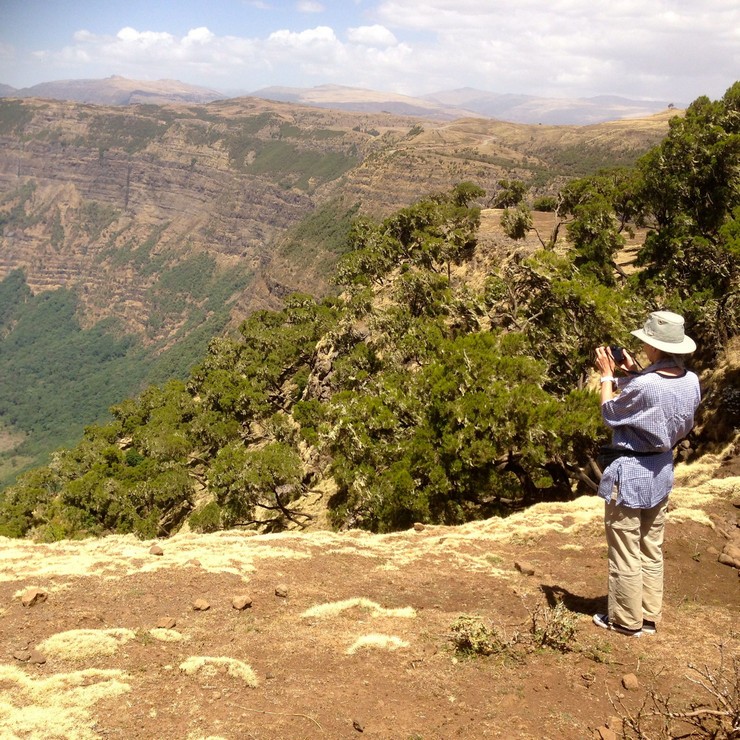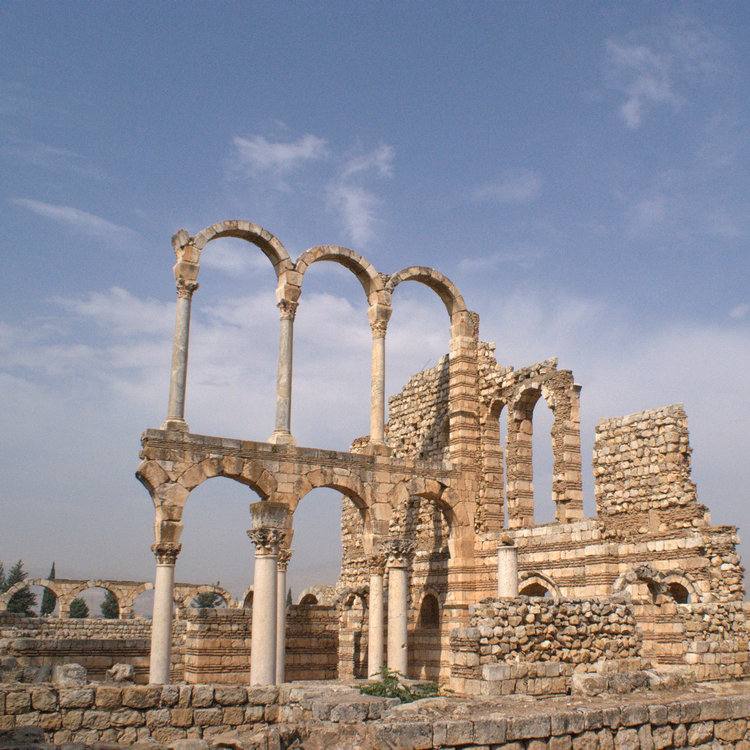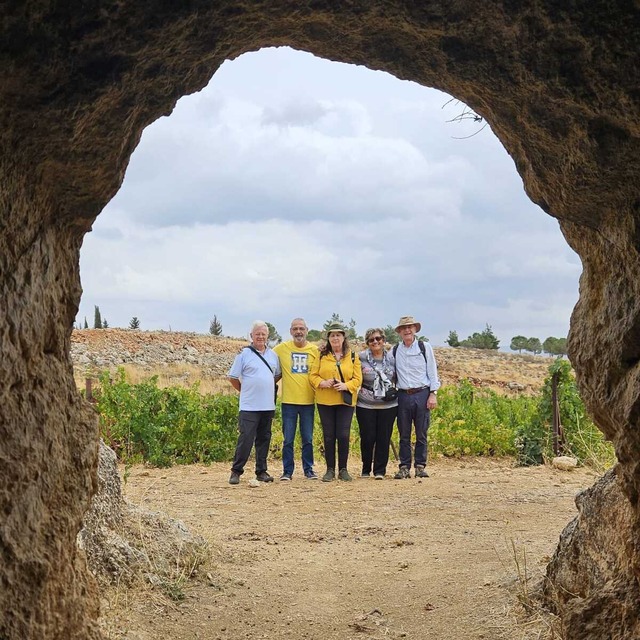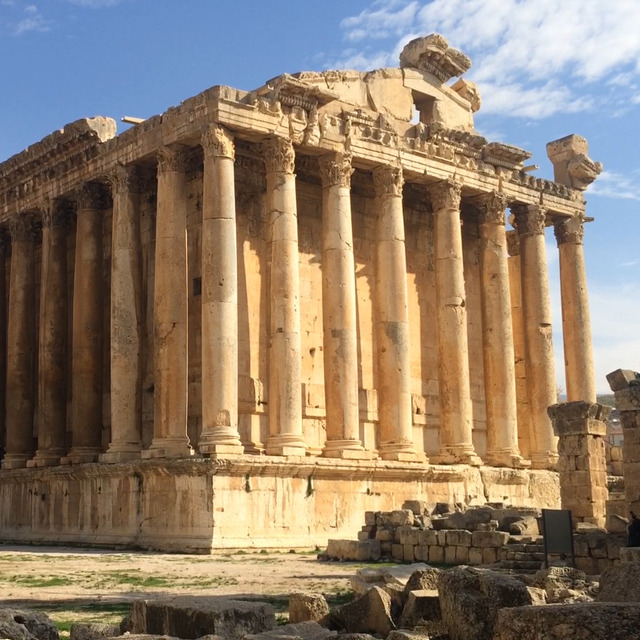
Day 1 : Beirut
Arrive into Beirut airport where you will be met by a Travel The Unknown representative and brought to your hotel in downtown Beirut. The rest of the day is free. Overnight in Beirut.
Meal plan: n/a
Discover the taste of the Levant - from mouthwatering mezze and heavenly hummus to delicious falafel and scrumptious shawarma. Take a cooking class in the famous kitchens of Le Bristol Hotel, learn the art of sweet-making from the experts at the world renowned Abdel Rahman Al Hallab pastry shop and sample wine in the natural caves of Ksara winery, one of the best wineries in the verdant Bekaa Valley. Visit the iconic archaeological sites of Byblos - birthplace of the alphabet and once the centre of the world’s shipping - and Baalbek - one of the most impressive Roman sites in the world.
Beirut - Byblos - Beiteddine - Jeita Grotto - Sidon - Baalbek

Arrive into Beirut airport where you will be met by a Travel The Unknown representative and brought to your hotel in downtown Beirut. The rest of the day is free. Overnight in Beirut.
Meal plan: n/a

After breakfast you will take a cooking class at the famous Le Bristol Hotel in downtown Beirut. Under the guidance of executive chef Georges El Murr you will learn to prepare some traditional Lebanese dishes. You will then have lunch at the hotel and taste the delicious food you have been involved in creating.
After lunch you will see the huge reconstruction project taking place to create a new commercial and residential district of the 21st century. This project resulted in the discovery that the capital is standing on the site of a very ancient settlement going back at least 5,000 years. Recent excavations have uncovered important archaeological sites from Canaanite, Phoenician, Persian, Roman, Byzantine, Umayyad, Abbassid, Crusader, Mamluke and Ottoman eras. The 1.80 sq. kilometres reconstruction project includes new buildings constructed in the traditional style, as well as hundreds of old structures that have been restored and renovated to their original form, including Beirut's souks and several historical mosques and churches. Visit the site of the famous Green Line which divided the city into various sectarian factions during its darkest years - from the mid 1970s up to 1990.
Proceed to the famous Corniche waterfront and stop for a short walk in the favourite promenade of many Beirutis. Further along, the road climbs steeply to a cliff edge, which is the headland of Beirut, with an array of cliff-top restaurants and cafes, a panoramic view of the bay and of the famous Pigeon's Rock. A road then leads down, stretching out to a beautiful sandy beach and the prestigious residential area of Ramlet El-Baida.
Dinner with drinks and entertainment at a local restaurant. Overnight at the hotel in Beirut.
Meal plan: Breakfast, lunch & dinner

After breakfast we visit Byblos, a town 37km north of Beirut whose history goes back 7,000 years and claims not only to have spawned the world's first alphabet but also to be the worlds oldest continuously inhabited town. Visit its ancient sites, and then explore the old part of the town on foot, starting with fishermen's harbour (which was once the epicentre of the world's shipping), continuing uphill towards the Church of St. John the Baptist and Byblos' beautiful souks.
You will stop for a lunch of Lebanese mezze and fresh fish at a local restaurant. After lunch you will continue north to visit Lebanon's second largest city, Tripoli. The city has its own unique character and a historical wealth that goes back to 14th century BC. Of most interest however is its old town, which includes sites from the Mamluke era, including colorful souks, hammams, khans, mosques, narrow alleyways and theological schools (madrassas). All are within easy walking distance of each other. You will also visit the Crusaders Fortress of Raymond de Saint-Gilles. Finally you will attend a Lebanese sweets demonstration at the world renowned Abdel Rahman Al Hallab pastry shop. Return to the hotel in Beirut for overnight.
Meal plan: Breakfast & lunch

After breakfast, drive south along the coast and then cut eastwards before stopping in the charming town of Deir el Qamar, a village consisting of stone houses with red-tiled roofs. Between the 16th and 18th centuries the village was the residence of Lebanese governors. Next you will continue to the imposing palace of Beiteddine. The palace is the best example of early 19th century Lebanese architecture, built over a 30-year period by Emir Bashir. Visit the palace complex and its museums housing costumes & weapons of that era as well as a fine collection of well-preserved Byzantine mosaics. You will take lunch at Al Akd guesthouse in Barouk, and participate in a cooking demonstration of local food typical to the village. In the afternoon visit the Barouk Cedars. It is a nature reserve in the Chouf District of Lebanon and has an area of 550 km2. It is an Important Bird Area(IBA) and Eco-tourism area. It hosts 32 species of wild mammals, 200 species of birds, and 500 species of plants.
Return to Beirut. In the evening you will visit a local restaurant for a fish dinner with arak. Overnight in Beirut.
Meal plan: Breakfast, lunch & dinner

Breakfast and departure to visit Jeita Grotto, a beautiful natural wonder considered to be the best caverns in the Middle East. Transfer by cable car to the caverns, which consist of two parts, lower & upper galleries. The lower ones are visited by boat, the upper caverns on foot. Enjoy the refreshingly cool temperature, the sound of rushing water and columns and sculptures that have been formed by water and time, supported by an effective lighting system that allows you to glimpse the uppermost roofs.
Return to Beirut. Afternoon free. Overnight in Beirut.
Meal plan: Breakfast

After breakfast drive to Tyre, 83km south of Beirut, a town that was declared as a World Heritage Site for its historical importance. Visit the excavated ruins which consists of three parts: the south side of the old Phoenician island-city that includes a large site of colonnades, public baths, mosaic streets and a rectangular arena; the northern site ruins observed from the road; the third area on the landward side east that consists of the most impressive archaeological remains, such as the Roman necropolis and hippodrome. Drive back along the coastal road to visit another important Phoenician town, Sidon, with its Sea Castle and old covered souks.
Fish lunch at a local restaurant in Tyre (including Lebanese mezze) After lunch Lebanese sweets tasting at Al Baba pastry in Sidon. Return to Beirut for overnight.
Meal plan: Breakfast & lunch

Breakfast and departure to visit Baalbek. Cross the Mount Lebanon range and drive through the Bekaa Valley towards Baalbek, 85km from Beirut. Here you will visit Lebanon's greatest Roman treasure, counted among the wonders of the ancient world. The site includes the temples of Jupiter, Bacchus & Venus, with the remarkable Great Court and the Hexagonal Forecourt.
We will stop for a tasting of the local specialty Lebanese meat sandwiches (Safiha). In contrast to the modern use of lamb or beef, traditional safiha are open-faced meat pies made with ground mutton. Next we continue to Ksara winery for a wine tasting and lunch. Return to Beirut. In the evening we will have a gala dinner with entertainment at a local restaurant - including an open regular bar. Overnight in Beirut.
Meal plan: Breakfast, lunch & dinner

After breakfast transfer to the airport for onward flight.
Meal plan: Breakfast
Learn recipes, sample delicious mezze and sip on fine wines
Discover Lebanon's panoramic ridges and isolated monasteries by foot
Explore Lebanon's spectacular sinkholes and cave complexes
Experience Lebanon's lofty ski slopes or try your hand at snowshoeing
Roman sites, rich culture and cedar forests
Ancient ruins, natural wonders and the hidden treasures of Lebanon
Discover the flavours of the Levant
Discover ancient history, archaeology & architecture
Discover Phoenician history, sublime ruins & fine wine
Hike through the verdant and historic Qadisha valley
Mary , Hiking the Holy Valleys, LebanonThe Qadisha Valley is a beautiful and fascinating place. The night in the monastery was a highlight for me although both the other home stay nights were equally enjoyable in their own way. Danielle made me feel particularly welcome and my guides looked after me very well throughout.

Joanne Hyde , Essential LebanonGreat mixture of everything. Of all the places we visited, Byblos is a lovely town with great restaurants. Also, the lunch at the Eco place in the Bekka valley was stunning. While it was expensive, Lebanon is an expensive country and we saw more than we could possibly have seen by ourselves. Best holiday in a long while. Travel The Unknown were flexible and professional to deal with and put together a trip for us that was one of the best holidays in years. Would definitely consider Travel The Unknown again for future trips.

Charles Harpum , Essential LebanonThe trip to Lebanon was first class in every way. In the four full days of the tour, we saw all the main sights in the country and some extras were thrown in. The guide and driver were outstanding. The accommodation was good and the food was absolutely superb.

Chris Thompson , Lebanon ExplorerThe Lebanon Explorer visit was a pleasure from start to finish. From a personal and friendly approach to booking to the seamlessly organised and well paced itinerary, the trip was highly memorable. Our guide was always ready to help us to understand the complexities of everyday life in Lebanon as well as providing entertaining information on the rich historical and archaeological sites. For me, the best part was that I didn't feel rushed.

Andrea Nutter , Tailormade LebanonTravel the Unknown is now our travel company of choice. It is really easy to deal with Rahul, the destinations offered are very comprehensive and all aspects of the trips are carefully chosen - itinerary, accommodation, meals etc. Our guides have been superb. They are knowledgeable, helpful, friendly and always happy to suggest tweaks to enhance the experience. The drivers are equally good and willing to go the extra mile - literally too. All in all, a first class company.

Robert Williams , Lebanon ExplorerMost of my 40 years of travelling across the globe has been independent travelling with the occasional exception. My recent organised tour of Lebanon with Travel The Unknown was excellent a diverse and great trip. It was a great way of seeing such a small and wonderfully diverse country in a short time, a truly great place!! Rahul and his team were responsive, knowledgeable and a real pleasure to do business with them. The local guide was excellent and the driver friendly and helpful. I strongly recommend them if they travel to a country you want to see albeit do not want the effort, hassle and planning to travel independently.
